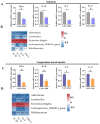Dietary Glyceryl Monolaurate Supplementation During Pregnancy Enhances Fetal Intrauterine Development and Antioxidant Capacity in Sows via Microbiota Modulation
- PMID: 40722887
- PMCID: PMC12291777
- DOI: 10.3390/antiox14070783
Dietary Glyceryl Monolaurate Supplementation During Pregnancy Enhances Fetal Intrauterine Development and Antioxidant Capacity in Sows via Microbiota Modulation
Abstract
This study elucidates the mechanisms underlying the positive effect of glyceryl monolaurate (GML) on fetal intrauterine development via maternal gut-microbiota modulating effects using a sow model. Addition of GML (1000 mg/kg) improved neonatal intestinal conditions (jejunal villus height, VH/CD ratio and tight junctions) and dorsal longissimus muscle (MyoD, MyoG and MSTN) development in the GML-treated group. Furthermore, GML improved maternal gut microbiota composition by enriching short-chain fatty acid (SCFA)-producing bacteria Lactobacillus and Akkermansia. Meanwhile, SCFA concentrations in sow feces and newborn plasma, as well as their receptors (GPR41/43) in intestine and muscle were upregulated with GML, corresponding with enhanced antioxidative and anti-inflammatory capacity. Further correlation analysis revealed Akkermansia and Lactobacillus positively correlated with SCFAs, antioxidative indicators, and anti-inflammatory capacity markers. Moreover, GML inhibited the activation of the MAPK/NF-κB inflammatory signaling pathway. In summary, GML enhanced fetal intrauterine development by modulating sow intestinal SCFA-producing bacteria.
Keywords: SCFAs; antioxidative; glyceryl monolaurate; gut microbiota; intestinal; longissimus dorsi muscle.
Conflict of interest statement
The authors declare no conflicts of interest.
Figures









Similar articles
-
Enhanced Antioxidative Capacity Transfer between Sow and Fetus via the Gut-Placenta Axis with Dietary Selenium Yeast and Glycerol Monolaurate Supplementation during Pregnancy.Antioxidants (Basel). 2024 Jan 23;13(2):141. doi: 10.3390/antiox13020141. Antioxidants (Basel). 2024. PMID: 38397739 Free PMC article.
-
Effects of supplemental seaweed extract on antioxidant properties, loose stools, gut microbiota, and its metabolite composition in adult dogs.J Anim Sci. 2025 Jan 4;103:skaf149. doi: 10.1093/jas/skaf149. J Anim Sci. 2025. PMID: 40522115
-
Maternal Clostridium butyricum supplementation during late gestation and lactation enhances gut bacterial communities, milk quality, and reduces piglet diarrhea.Comput Struct Biotechnol J. 2025 Jun 25;27:2933-2945. doi: 10.1016/j.csbj.2025.06.040. eCollection 2025. Comput Struct Biotechnol J. 2025. PMID: 40687998 Free PMC article.
-
Therapeutic strategies for hypertension: exploring the role of microbiota-derived short-chain fatty acids in kidney physiology and development.Pediatr Nephrol. 2025 Jul 10. doi: 10.1007/s00467-025-06883-2. Online ahead of print. Pediatr Nephrol. 2025. PMID: 40637840 Review.
-
Role of the intestinal flora-immunity axis in the pathogenesis of rheumatoid arthritis-mechanisms regulating short-chain fatty acids and Th17/Treg homeostasis.Mol Biol Rep. 2025 Jun 21;52(1):617. doi: 10.1007/s11033-025-10714-w. Mol Biol Rep. 2025. PMID: 40544212 Review.
References
-
- Lin Y., Yan H., Cao L., Mou D., Ding D., Qin B., Che L., Fang Z., Xu S., Zhuo Y., et al. Maternal organic selenium supplementation during gestation enhances muscle fiber area and muscle fiber maturation of offspring in porcine model. J. Anim. Sci. Biotechnol. 2022;13:121. doi: 10.1186/s40104-022-00773-5. - DOI - PMC - PubMed
Grants and funding
LinkOut - more resources
Full Text Sources
Miscellaneous

